
The weekend has barely begun, and here I am ogling vintage ’70s land yachts on CL, via one of my favorite Facebook groups, Finding Future Classic Cars. And it will no doubt come as no surprise to most of you that one, it is a Continental, two, that it is pastel yellow, and three, that it is from the 1970s. The trifecta! So let’s check out this 1974 Continental Mark IV.
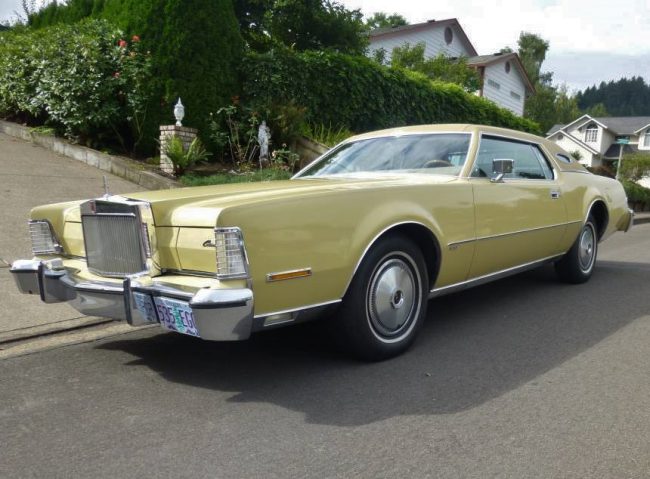
As with my Brougham lust for 1971-76 Cadillac Fleetwood Broughams, my equal fascination with the 1972-76 Continental Mark IV is due to my having a little diecast version of one when I was a kid. Also, my grandfather, Bob Klockau, had a triple dark green 1972 model. Also, Cannon is just about my favorite TV show. So every time I see one, I go back in time.
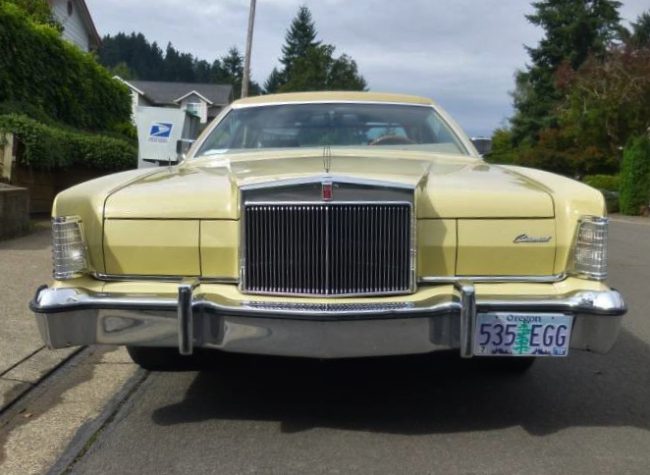
While the Mark IV started off with svelte, shapely bumpers for its inaugural year in 1972, federal standards quickly changed that. Starting in 1973, that delicate front bumper was replaced with a much more robust unit, as seen here.
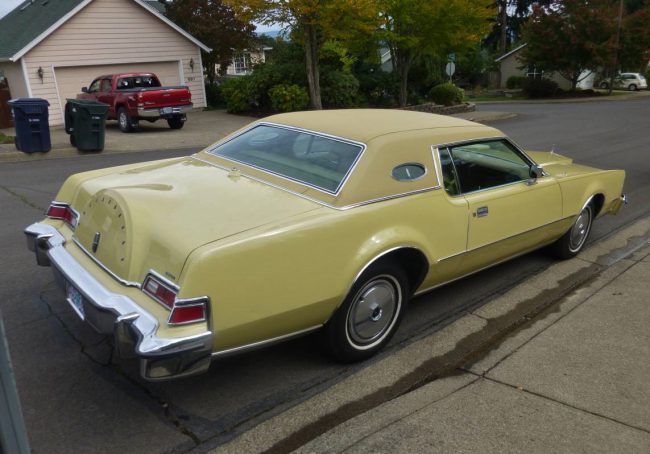
When the ’74s appeared in Autumn 1973, the rear bumper got the same treatment. And while I prefer the ’72, I don’t mind the big-bumper 1974-76 models either. I’m a hopeless case when it comes to ’70s Lincolns. Like a starving man at a steakhouse, I like everything.
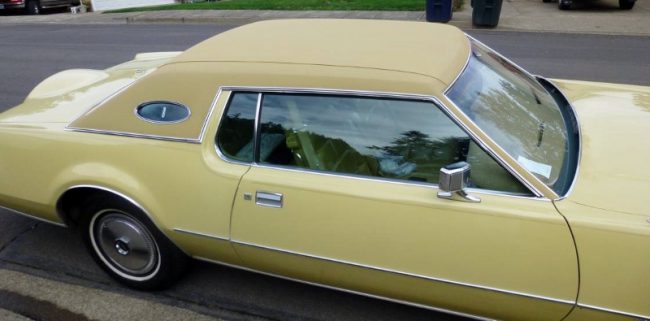
As Rodney Dangerfield famously quipped in the 1986 comedy, Back To School: “Have you ever looked at a menu and said, OK?” That’s me, when it comes to ’70s personal luxury cars, haha.
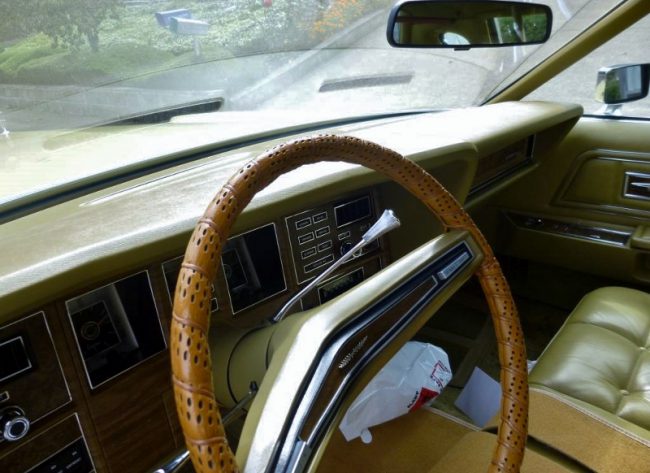
Continental Mark IVs by this time were outselling its arch-rival, the Cadillac Fleetwood Eldorado. In 1974, 57,316 of the $10,194 Mark IVs came off the line at Wixom, MI, compared to 32,812, $9,110 Eldorado coupes and 7,600, $9,437 Eldorado convertibles.
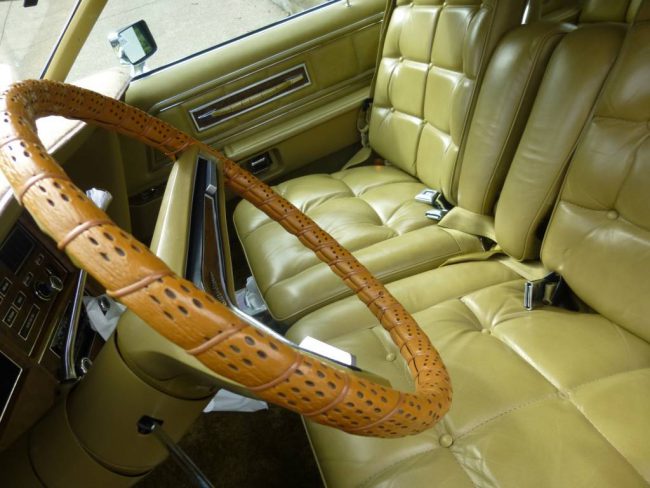
However, Cadillac was still handily trouncing Lincoln in total sales, helped by a much more extensive model lineup, including formal sedans and limousines.
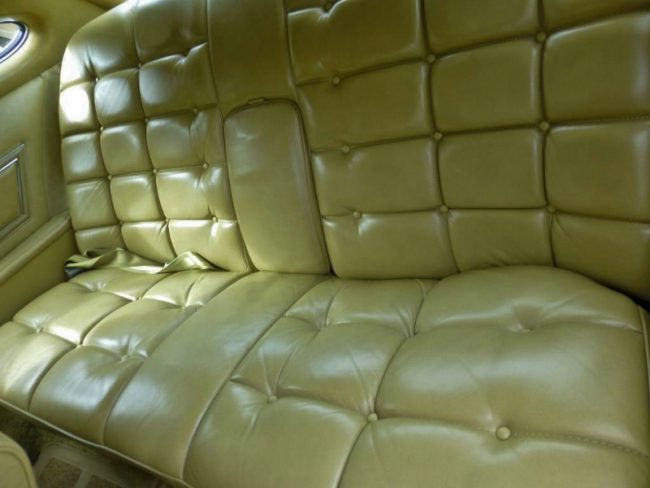
One thing Lincoln was really jumping into by 1973-75 were special edition Mark IVs. With such packages as the Silver Luxury Group, Gold Luxury Group, Blue Diamond, and others, the sky was nearly the limit for personalizing your new Mark IV.

But even the standard Mark IV was a fully equipped car. Standard features on both the Mark IV and Continental sedan and coupe included WSW steel-belted radial tires, 460 CID V8, Select-Shift automatic transmission, automatic temperature control, power seats, power windows, power steering, power brakes, automatic parking brake release, and cornering lamps. Our featured Mark IV is currently for sale in the greater Portland area, finished in Maize Yellow, with matching top and interior. I was smitten as soon as I saw the pictures.

Since it is still relatively early in the year, there are still many with “Barrett-Jackson-itis” with overly inflated ideas of what their vintage car is worth. And of course pictures can hide a multitude of issues that are apparent once viewed in the metal. But this particular Mark IV looks remarkably well-preserved, and the $5,900 ask does not seem unreasonable. So if you’re near Portland and suddenly have a hankering for 1970s personal-lux excess, you can check out the ad here. As for me, I already have two Lincolns, and they look like Chevrolet Corsicas size-wise compared to this ’74 IV, so I will just ogle the pictures and call it good!
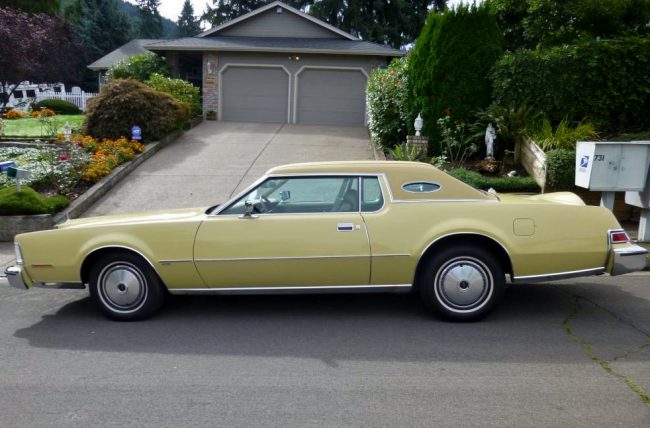







43 Comments
Interesting that the Mark IV so handily outsold the slightly cheaper and more advanced Eldo. Part of that might be the 71-74 Eldo not being as good looking as the 70s or 75s. It may also be that the buyer was more interested in how the car treated him than how sophisticated the engineering was. Plus by then the incrowd culture was not giving credit to the big three for anything they did. The leaders of the big three were Nixon lackeys and their workers were the former sharecroppers that replaced immigrants and ruined so many northern cities. Nixon still had the silent majority and here was their car, If only in the heartland, and the ghetto.
How much of it was just that cars this big only make sense in some environs? Today there are people who live in places where they can’t believe full sized trucks can work as personal use vehicles. That’s because they don’t work in crowded places with parallel parking and thieves. I grew up in a place where the real money lived on horse-farms and in remote private neighborhoods. In the ’60s, ’70s and ’80s, these private refuges were connected to town by roads that wound between and over hills. They weren’t crowded with slow moving traffic like today, nor were they heavily policed. Detroit parade floats made no sense whatsoever to the landed gentry of Albemarle County forty years ago. Not when a 300SD or 911SC could make the trip to Farmington a pleasure instead of a chore.
I wasn’t raised in a wealthy neighborhood far from town. There were plenty of new Lincolns and a few new Cadillacs(especially Sevilles, oddly enough) in the day, although that stopped around 1980. Most of the buyers were older, but one neighbor did get a new Mark Roman Numeral each year in the ’70s. Riding in them to little league practice made me think he replaced them when they filled up with cigarette butts, but actually he was a traveling salesman who got a new one as a company car every year and bought the old ones to stack up in his driveway.
In the ’80s, even my middle class neighborhood switched over to imported premium cars. My theory is that the Detroit luxury cars of the day had stopped being good cars. Nothing with an HT4100 was as good as anything with an M30. The only thing exceptional about a ’70s Lincoln was its size. When they started putting their badges on ever smaller cars that were easily recognized as Fords and Mercurys, the brand equity they’d been cruising on vanished into thin air. Blaming political change on the extinction of these cars is ignoring the impact of CAFE on their quality, on the regional nature of their practicality, and lets Detroit off the hook for thinking so little of their customers. I was active in the Albemarle County Republicans thirty years ago. Looking at the parking lot, one might have thought our meetings were being held by a German car club. It wasn’t that long ago that the Democrats were the party of organized labor and protectionism.
The Mark’s sold well because they really had no other competitor in the Lincoln line up, Lincoln sold a hand of full size coupes non-Mark Lincoln Continental coupes, usually under 10,000. Compare that too Cadillac which sold 100,000 Coupe deVilles AND 50,000 Eldorados at the same time.
If buyers weren’t interested in tech, how did the Eldorado blow past the bigger RWD Mark when it downsized in 1979?
I am surprised how well the 79 Eldo did with the major size reduction, It did nothing to attract the landed gentry of Albemarle apparently, but what really was more fun than a 300SD, with the engine they were too embarrassed to put in a German W116. You make a valid point on the preponderance of Coupe De Villes then.
There is nothing that can quite compete with the thrill of a 300SD….its like the 4th of July, New Years Eve and your first handjob all in one…..I’m getting aroused just thinking about the horsehair and vinyl MB Tex upholstery…..mmmm….”I paid so much for this…..I’m so going to impress people I don’t even know…..I want everyone to think I’m smart and important….mmmmmmm”
“I saw no Indian Elephants in my neighborhood when I was a kid 40 something years ago, hence forth, no one likes Indian Elephants and I even doubt that they really exist”
Same logic.
Back to the subject at hand in reality land.
Lincoln had an odd relationship with coupes, even stranger was that it was during Americas “I love 2doors” phase where any 2 door hardtop was a solid seller, Lincoln didn’t even have a 2 door car of any kind from 1961-1965.
Well remember though they had Thunderbird, that was quite upscale unitil Lido had the brainstorm to put a RR grille and real wood on it and make a Mark III. I think the volume and transaction price of the two were higher than the earlier Tbird alone. One ship going against the import tide. After Lido, came the sadness of trying to differentiate fancy Mustang/Fairmonts with Tbirds and Mark VIIs, as if there wasn’t already a Cougar for that. Yet weirdly, those were the ones our 300SD fans/friends are less put off by. Well true giants Henry III and Lido being replaced by hacks like Caldwell and Peterson must have made their day.
Did you notice that I pointed out that different cars work well in different regions? The 300SDs I rode in had leather, not that MB-Tex wasn’t better than velour in the days when so many people smoked. Impressing people you don’t know is for people who are not of any importance whatsoever. Why wouldn’t people know who you are if they matter?
Lincoln had something better than 2-doors from 1961-1965. They were combining distinctiveness and elegance. Then they stopped, and they benefitted in the short-term by selling lots of cars to people who thought it was cool to drive Faux-Royces. Then they stopped benefitting, like many an aging prostitute has learned the hard way.
Honestly, the 1961-1965 Continentals are a little plain and a little overrated, Pretty cars for sure
but in my opinion, not prettier that a 1963-1965 Riviera for example or lots of other great looking cars from that era. They are nice cars and Lincoln did sort of luck out with them, it was either that re-hash of a Thunderbird proposal or the glue factory for Lincoln so its guess that turned out well for them.
These were probably the only good thing to come from Robert McNammara’s cost cutting at Ford.
I can rather understand the 450SE. An OHC small block V8 and the reasonably sleek shape did get top speed up thereby fueling autobahn dreams, especially the years it had 190hp instead of 160hp. The smaller engines 120hp gas and deisel just emphasized how much weight(400 pounds) was gained from the previous S Class while doing very little to fix the perennial problem of noise and lack of creature comforts. Mercedes seemed to have a real mental block with their 6s of breaking 3.0 liters as if it was still 1955. With Jaguar offering a 176hp DOHC 4.2 six and the 5.7 170hp V8 in the cheaper Seville models you wonder what they were thinking. Of course the situation ended up with Mercedes 80% diesel in the USA, making it impossible to make any sensible argument about refinement or performance. Just the image of white coated German engineers, nevermind the strong smell of Turkish delight coming from the Sindelfingen factory cafeteria,
That all diesel boom period only lasted for a little while for MB, buyers with means probably thought they we’re hedging against the upcoming embargo sequels IV and V but then gas started getting cheap again around 1982-83 and they found themselves in kind of a hairshirt car that they really didn’t like all that much.
From 1982-1985, there were no gasoline engines in the W123(“E-class”) lineup in the US. Three out of four S-class cars sold in the US were turbo-diesels the same years. People were so unhappy with their diesel Mercedes-Benz cars that Mercedes-Benz had to come up with diesel options for years after they stopped making fuel consumption or drivability sense.
Tom, as a current Mark IV owner and previous owner of two 72 Mark IVs and one 76 Thunderbird, all I can say is join us …,
“One of us, one of us, one of us”
Tom,
When you look at this car, which began the short era of total choice, it almost seems like it’s from a different universe. Look at the brochure for this car and the Mk IVs and Vs that followed (even the MK VI). The number of luxury groups, designer series, diamond/collectors series, interior sew patterns, fabrics, leathers, colors, three or four roof choices, seldom did a car hit the marketing mark like this one. It literally anointed the buyer. Critics bring up the poor allocation of its 19 feet and the de-smogged engine, but that’s missing the point. Buyers just didn’t care. It was a winner!
It has crossed my mind that FoMoCo in the ’70’s had a bunch of very similar styled cars that somehow did not cannibalize sales from one another. The Thunderbird and Mark IV, along with the similarly styled Montego, Cougar XR-7, Torino Elite, later just Elite, all shared the same basic styling but totally different transaction prices. Just about anything you could want on a Mark IV you could get in a Cougar, which should have made it the outstanding deal at your local friendly Lincoln-Mercury dealer. But, they kept on shoveling the Marks out the door, at least in my neck of the woods.
I guess size did matter, and maybe that’s why the Mark managed to hold it’s own over it’s smaller cousins. The Cadillac Eldorado was not nearly as popular, and the Imperial really didn’t compete directly against the Mark IV and the Eldo in the personal luxury space, at least as the latter two defined it.
While not my cup of meat, I’m still glad to see these beasts are around for us to marvel at once more. When I was a kid, these things were the ne plus ultra of American luxury. I was aware of and similarly impressed by the Mercedes 280 SLs. But the West German mark was quite expensive then and the bigger motored versions would have been way beyond what the “small block” 280 SLs commanded in dollars. The smaller Merc didn’t have the grunt and presence the Mark (and Eldo) possessed.
True story: In 1978, I went car shopping with my father (unknowingly for the last time). He had been forced into retirement due to his health, but wanted to get a nice car for his retirement and for my mother to drive, that was his story and he was sticking to it… The new for 1977 Mercury Cougar XR-7s had caught his eye and was interested in the 1978 version.
While there, another man was having a rather loud discussion with the service manager about the durability of his Mark IV. I sidled over closer to where the discussion was taking place and sneaked a look at the Mark. The engine had been hoisted out of the car; there was a huge hole in the side of the block, with the small end of one of the connecting rods hanging out of it. It turns out Junior had been drag racing the Lincoln when dad was out of town. Dad was P I S S E D when he found out that the repairs were being denied due to evidence of racing. I guess the bald rear tires should have been a clue…
Your father would have been wise not to let you loose in the XR7, the last coupe home for the Cleveland 351 V8 perhaps with buckets and console with Farah Faucet selling it. Could be fun racing 360 Magnum XEs and 350 Cutlass W31s and yes 450 SLCs while waiting for the maturity to appreciate a Mark.
Well, the XR-7 never happened, as he passed before he could complete negotiations. My mother carried on with the 1974 Montego instead, not wanting to incur debt after my father’s passing. Dad was actually a Cadillac guy. I think had he wanted a truly big car in the driveway, it would have been a Sedan deVille. But, he liked those Mercurys and bought a bunch of them over the years.
Of course the Montego is related to all the cars we are talking about. People poo-poo them as the most oversized midsize. That is correct but think of what value they were. Iacooca would have known that the boxy Granada was coming so he let the Torino grow to a proportion that could support a decent Tbird, cop car, taxi, 3 row wagon whatever. Letting the Granada be the real mid size and stake a higher and more profitable ground than Maverick. You parents sense that low end Torinos on the big platform are loss leaders and stripped and switch to the Montego to get at least Granada level trim in a cheap but decent size package. The package is so right sized that later it looses a bit of the 70s fuselage and becomes the next full size, the Panther. Well played. There is talk that the transmission was sub par, not being up to the weight, how if you remember, did your parents example do?
While we owned the Montego, the worst mechanical issue we had with the car were some emissions control problems, mostly with the PCV system. I don’t recall what the exact problem was, but it seems to me it was easily remedied once diagnosed properly. IIRC, the car was a 302/FMX autobox, bog slow, but reliable. Mom drove the car until 1981, until the rust monster took over…
I should note that in my observation about the Hot Rod Lincoln, the “Dad” mentioned was not my father, but the man who owned the Lincoln with the hole in the block. My family usually had nice Mercurys, but no Lincolns. Re-reading it, I could see where one could imply that the Dad was my father, but he was not.
“I’m tellin’ you son, you’re gonna drive me to drinkin’/if you beat the shit outta my Hot! Rod! Lincoln!!!”
Raise your hand if you had a car with the steering wheel wrapped with that stuff in that color.
My hand is raised.
I actually like the front bumper set up on these cars. The rear bumper is a bit too much bumper. But it was what it was and that was the best they could do at the time.
Sport-Grip!
My Grandma had those in every car! Sometimes two or three per!
Everyone has had to have had at least one…….
Why did MB keep their sixes below 3 liters for so long? Because European countries had displacement taxes that went ballistic somewhere between 2 and 3 liters (depending on country). This was a major reason why Detroit could never sell any cars in Europe, as a 7+ liter Cadillac or Lincoln would cost way too much to buy and operate even if you dared to navigate the big yachts on the narrow cow paths they called streets.
Another reason for the decline of Detroit in the US premium market was quality. I remember carefully comparing the paint quality, interior fitting quality, panel fit, and door slam sound of the brand new 1979 Eldorado owned by a friend’s parents with my parents 1978 530i, and we both agreed it was no contest in favor of the BMW. I remember my friend (who really didn’t particularly like “foreign” cars) saying the door jamb paint on the BMW was much smoother and more evenly applied than the exterior surface paint on the Eldo. And the sad thing is the Eldorado was much more nicely put together than any Lincoln Mark from the 1970s that I similarly examined – I couldn’t believe all the paint drips on the bottom of the door of a car that expensive. On the other hand, the BMW couldn’t hold a candle to the build quality of the 1966 Sedan deVille my parents owned earlier, so it isn’t like Cadillac didn’t know how to do a great interior, or smooth paint, or flush body panels, or even door gaps – they just stopped doing it because it was cheaper to use cheap materials and indifferent quality control.
Think with MB and their high prices it was more to do with the thought that the mid 50s 300SL engine was their pinnacle. Think about the 2.8 six MB was offering in the 70s and early 80s. Adding a Twin Cam head and a Solex copy of a Rochester 4 barrel to try to keep it competitive. Why not just grow displacement. Then when they finally brought back the 3.0 in the mid eighties, remember the hoopla over the 300SL in 1985 in Germany.
On the 530, did the BMW had little caps on the door were the window winders should be? Was the air conditioning properly engineered? Did the thermal reactors work as advertised or just overheat the engine, cracking the head? Had they switched to the long lasting GM automatic or were they still using the short lived ZF unit? The list of core competencies at BMW of the day was not long. Your family was choosing the BMW because it more fit their image, which is okay and what Lincoln buyers did as well.
Actually, my parents owned the 530i until 1992 and it was trouble-free throughout and still looked and drove like an almost new car – my classmate was thrilled to buy it and drove it several more years until the clutch went and he sold it to his mechanic. No caps in the door panels on the 5 series, I think that was only on the e30, and the A/C worked great (although no climate control as in the Caddies). My parents chose the 530i because they didn’t want to drive an aircraft carrier around, they liked getting 20-24 mpg instead of 10-14 mpg, the seats were far more comfortable than any American car of the era (only Volvo was better), and they liked a zippy car (0-60 in 8-9 seconds instead of 12-14 for a Lincoln or Caddy of the era). My grandparents continued to be loyal Cadillac buyers so I always had a point of comparison, and it was just sad how the quality and performance of American luxury brands kept slipping and slipping and slipping away until reaching bottom in the early 90s.
Glad your family got good service from it. Proves that problem areas don’t necessarily impact every individual car. I was trying to come up with American sold manual sports sedan competitors in 1978. Aside from a few much less sporting Euros from Volvo and Peugoet, I am at a loss. There were a few manual V8 Grand Ams but it is too much to expect them to compete with a car costing twice as much. So the BMW was a unique offering, and therefore deserved to earn for alias Willie Brandt his prized export exchange. Good job.
A 1979 Eldorado was about 8-9 sec 0-60 car as well believe it or not. 8.5 from the 79 C&D I have from what I recall.
I’d say that early 90’s were far from “bottom” but what ever, by 1989-1990 Cadillacs got some power again with the 4.5, real wood returned to the interiors and the “too small” 1985-1986 styling was being remedied as much as it could without a full restyle and the hated Cimarron was gone.
I would consider 1986 the very low point for Cadillac, the E/K cars landed with a considerable thud on the marketplace, the 4.1 was still fighting off the reputation of being a boat anchor even with improvements, the DeVille and Fleetwood were still selling well but they were still dealing with the issues of too similar “GM Styling” that Lincoln pointed out in its commercials.
Without quibbling about the 1979 Cadillac Oldsdorado’s numbers, why exactly was it so much faster than the later Cadillac 368 powered Eldorados?
I suppose they dropped the pleasant Oldsmobile 350 from the Eldorado because it returned 11 MPG in the city. How bad were the big Eldorados?
http://testdrivejunkie.com/1979-cadillac-eldorado-test-drive/
1979 was the year BMW launched the 528i, which maintained almost all of the 530i’s desirable qualities while offering what constituted exceptional responsiveness and reliability from its new engine management and catalytic converter. Better mileage too. They kept it around for ’80 and ’81 too, while Cadillac replaced the competitive Oldsmobile engine with the slow 368 and even more unfortunate variable-displacement variant.
I am amazed the Eldo did so well 0-60 versus the BMW where they would have never tested anything but the stick shift. Goes to show what happens when power is available at lower rpm where it can actually be used. The similar horsepower was available at what, 2000 rpm less. I bet it beat the BMW in cruising sound level by a good 3 or 4 decibels. Another performance measure that can actually be enjoyed in everyday driving. The hard part for Caddy would have been keeping the sound level down while getting so much smaller. In 79 it was still up against the huge Mark V. From all I have heard it did this, no small feat of engineering that somehow always escapes our German friends, even the 20 percent that weren’t diesel.
I’ve now found two sources for the 1979 gas-injected Oldsmobile 350-powered Eldorado saying 0-60 in 9.7 seconds and a 17.7 seconds in the quarter mile, so no really as fast as a manual BMW after all. Hope it was fun while it lasted. That was a good time for an emission-strangled, CAFE-geared lead sled, but Cadillac couldn’t keep it up and it still wasn’t import-humbling.
https://oldcarmemories.com/1979-cadillac-eldorado-smaller-can-be-bigger-and-better/
https://www.zeroto60times.com/vehicle-make/cadillac-0-60-mph-times/
170hp in the 1979 vs 140hp from the 1980? I don’t know the gearing for each one. “So much faster” is really about a second and a half in reality. I imagine the Oldsmobile 350 was lighter than the de-stroked but still based on a 472/500 6.0 368.
As to why they installed it? Maybe they wanted a Cadillac motor in the Cadillac to differentiate it from the Toronado and Riviera?
Ahhh…WTVJ’s Bob Mayer’s old Eldorado test, very cool, I did note that Bob did find that the paint work on the Eldorado was excellent and that it was “One of the smoothest and quietest cars he’s ever driven” and this was after he tested a Rolls Royce. That’s 11 city with the a/c on all the time. The big pre-79 Eldo’s were 8-10mpg with the a/c on in city driving.
By comparison Bob roadtests a manual no power steering 1979 Audi 4000 that achieved 20.9 in city driving with the a/c on all the time and a 1978 Audi 5000 with 5 cylinder, crank windows and automatic and it achieved 15.9 with the a/c on city driving. A 6 cylinder Zephyr did 15 in the same conditions.
Paint quality back then was sort of hit or miss depending on the color on a lot of cars too, without looking it up, I think this is when they started messing around with the paint formulas too.
Carmine – I’m sure that is true, but it shouldn’t have been hit or miss on a Cadillac, and it wasn’t in the 1950s and 60s when Caddies were the nicest finished cars in the world.
At least we’ve settled on a uniform standard for today-BAD. Unless its a hyper expensive car with real hand finishing and wet sanding, I was looking at a $120,000 plus black AMG GL outside my office the other day and it covered in massive orange peel from top to bottom
I believe the technical term for this color is “baby shit yellow”
Well, I tell you, I like looking at these old land barges but I don’t want to ever drive one again. These mid 60s to late 70s full size American cars were the cars of my youth, and they drove like POOP. Try to turn a corner and the whole thing tips up with about 20 degrees of roll. 90 degrees of free play in the steering. Touch the overboosted power brakes and the thing stands on its nose and tries to go sideways. Not to mention the myriad squeaks, creaks, and rattles after a couple years of driving. And terrible lower back pain from sitting on a seat that was less supportive than a pile of goose down pillows.
The traditional saying is “well, but they were great on the highway”. Yeah, if you don’t mind the fact that they wander all over the road and you have to make a million steering corrections every mile, each of which, considering the abovementioned 90 degrees of free play in the steering, is pure guesswork.
Remember the other cars of your youth. Like the 70s Corona where you could enjoy your twenty degrees of roll in the suspension and free play in the steering box with out any overboost in the steering only under boost, as in no boost. Amazing how those genious engineers could tune in all that roll with no ability whatever to absorb bumps or road noise. You could enjoy around the alleged 80 horsepower that accelerates like 60 hp because Japanese JIS horsepower is gross…ly optimistic. You could experience the joys of Japanese exterior design, they weren’t paying European stylists any more, and God they got ugly fast. The seats won’t remind you of pillows, except to remember to bring some from home next time. You won’t enjoy the highway, with an 18 mile an hour per thousand rpm top gear, but hey 55mph is the law. Feel free to insert Colt, 610, Leonie, Maxda 808, for the Corona, it’s not like any of the different manufactures had their own personality. Probably all assembled out of the same Kanban.
The fact that early 70s Japanese cars sucked doesn’t make the driving dynamics of Detriot land barges any better.
If I cast my mind back to say 1978, the cars that most closely approached being decent to drive were probably the Chevy Nova and its cousins from Pontiac, Olds, etc., Datsun 280Z (before the ZX disco cruiser), FOG Capri, the new Mustang (did that come out in ’79?), some of the AMC models (weird looking, though) – and MAYBE the Ford Granada? BMW 2002? Whatever the smallest Mercedes was at the time (but not in the diesel version that you had to stick your foot out and paddle to help it get up to speed)? Actually the VW Rabbit wasn’t half bad in the context of the time.
The fact that these were about the “best” cars around, tells you just how bad cars were in the mid 70s to mid 80s.
JC – this is precisely why my parents switched from American cars to Europeans in the last 1970s. One drive in a BMW, MB, or Volvo was all it took if you valued real comfort and nice driving dynamics over pure isolation and superficial “luxury”. Yes the Euros were expensive to buy and most had servicing quirks, but they didn’t rattle over every bump, the seats had all day comfort (although I always thought MB seats were too firm), the steering was precise and offered good road feel (BMW was best), and the cars tracked straight as an arrow on the highway without constant corrections making them much more relaxing to drive. They also featured nice tight turning circles, great visibility (unlike the Mark IV which was like riding in a bunker), and tidy dimensions that made them easy to park and maneuver through traffic (yet still had larger back seats and trunks – my 176 inch long BMW 2002 had a much nicer backseat than the 228 inch Mark IV for actually sitting in). There is a reason that Cadillac and Lincoln steadily lost customers starting in the 1970s to the Europeans and later the luxury Japanese brands, they just made better cars.
Stingray, your parents choice of a stick shift 530i seem a pretty hard core choice to have switched directly from a Detroit offering. If you remember, what were they coming out of and what did they cross shop?
John – a manual really wasn’t hard core in the 1970s and 80s when most BMWs were sold with a stick shifts (except the 7 series). In the mid-70s my parents were looking to get one “do it all car” to get rid of their thirsty 66 Sedan deVille (highway car) and their shoddily constructed 72 slant six Dodge Dart (city car). They didn’t want a full-size car (too big and thirsty), but instead something closer to the Dart in size but with a bigger trunk, better build quality, and more comfort. They looked at the Nova and Malibu (and GM clones) but the Nova had a very small trunk and a tight back seat, and Malibu had a small trunk in the sedan, a very rattle prone wagon, and was thirsty with the V-8 and gutless with the 6. The new Aspen and Volare were interesting, but they were leery of Chrysler quality after the Dart, and again the 6 was gutless and the V-8 thirsty. They hated the sloppy handling and lousy seats of the Ford Torino, and although the Granada was more promising it also didn’t have a trunk or wagon version, and was gutless with a 6 and thirsty with a V-8. They even looked at a K-5 Blazer, but didn’t want only 2 doors, didn’t like that it drove like a truck, and the gas mileage was no better than the Cadillac. Detroit vehicles really sucked in the 1970s.
Nothing Japanese was of interest – very uncomfortable seats and tinny sounding bodies, and generally too small. The VW Dasher was interesting, but turned out to be very noisy on the highway and was already developing a reputation of being trouble-prone. The Peugeot 504 wagon diesel was also interesting, but expensive and there was concern about getting them serviced with their very spotty dealer network. Thus they ended up with a Volvo 245 wagon demonstrator, which unfortunately for my father and me was an automatic (my mother was happy for an automatic). The 245 had more usable space than any non-full size domestic wagon (and very few rattles), handling was a revelation compared to the Dart or Caddy, they loved the front seat comfort, and it got a consistent 21-23 mpg on the highway (revving like hell without overdrive), which basically doubled the mpg of the Cadillac.
A couple of years later I got my first car, an 8 year old BMW Bavaria with 4 speed, and after my dad drove it for the first time and experienced that smooth 6 cylinder power he said his next car would be a BMW. Which started a string of BMWs for him (all with manuals until their current X3), while my mother insisted on having a Volvo wagon with automatic until the X3 satisfied them both. They have had very good service from the BMWs, and most of the Volvos, and frankly have not done much cross-shopping over the years due to their satisfaction with the cars and service.
I recently asked my dad what his favorite car was of all he owned over the years, and he surprised me by saying the 1978 530i. I was surprised because their more recent BMWs and Volvos have of course been faster, more economical, more comfortable and with more bells and whistles, but he said the 530i was just so much better in all ways that any car he had ever driven before (except my Bavaria) that is really opened his eyes regarding what was possible with automotive engineering and build quality. It handled better than most sports cars of the era, but also had a very nice ride (especially on bad roads with its IRS), it was fast like a sports car (and he loved rowing the gears on BMW manual transmissions) but got about the same mpg as the 98 hp Volvo (and better than the slant six Dart). It was smaller than the Dart, but had a much more comfortable back seat and comparatively huge trunk (again thanks to IRS). It also had better build quality and much more comfortable seating than any American luxury car of the time. The only down-side was it was expensive to buy, but since he tended to keep cars for many years that wasn’t such a big factor.
The sad thing for my parents is that Detroit didn’t offer anything remotely competitive in the 1970s and 80s, while at the same time performance and build quality were slipping constantly compared to the 1950s and 60s. If Pontiac had continued to develop and refine their IRS Tempest and OHC 6 from the 60s, or Cadillac had brought over the sophisticated Opel Diplomat or Senator instead of making a Seville out of the Nova, they might have been able to keep many of the customers (such as my parents) that migrated to foreign cars in the 1970s and 80s.
Interesting commentary.
I share Tom’s draw to this generation of Marx…no reason for it, none, except that FoMoCo was what lived in our garage in that generation.
Me, I’d go for a pre-bumper MIII, but still…oh, I guess, under my maturity and culture, there’s a playah living. The fake Rolls grille does it. So does the (pointless) long hood. Remember, this was the era of kits to turn a Beetle into a ’38 Ford or a Rolls with a standup grille. Or the garish Standard Motors fiber-fab constructs.
But…people gripe about GM’s Department of Badge Engineering; but Lido was pretty good at it, too. Under this MIV, is the same car that was the 1974 Galaxie 500. Or the Thunderbird. And of course, Lido later gave the Torino the Bird, and sales exploded.
So yeah…just for a taste of my dead, departed youth…I’d deal with the numb power steering, and the eight miles a gallon…for a time…